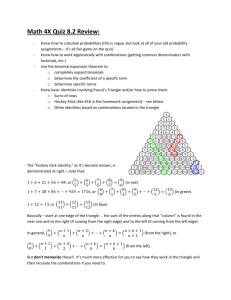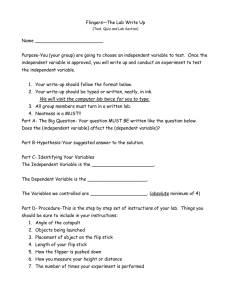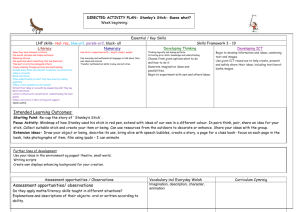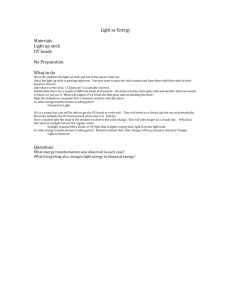18.440 Probability and Random Variables April 18, 2007 Department of Mathematics
advertisement
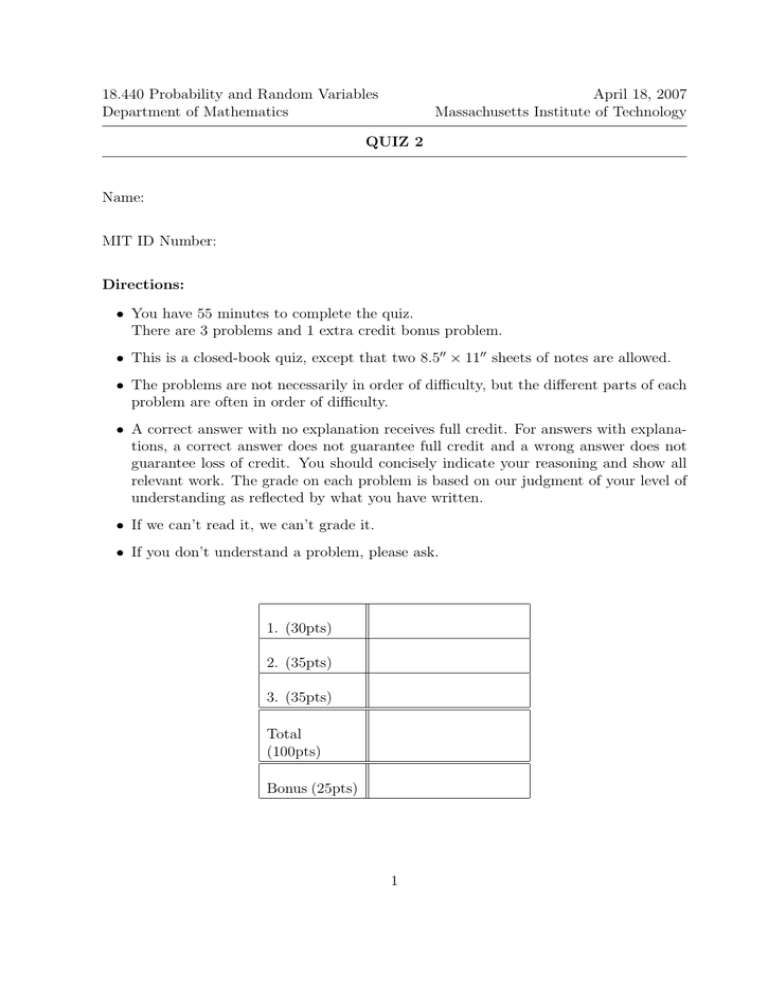
18.440 Probability and Random Variables Department of Mathematics April 18, 2007 Massachusetts Institute of Technology QUIZ 2 Name: MIT ID Number: Directions: • You have 55 minutes to complete the quiz. There are 3 problems and 1 extra credit bonus problem. • This is a closed-book quiz, except that two 8.500 × 1100 sheets of notes are allowed. • The problems are not necessarily in order of difficulty, but the different parts of each problem are often in order of difficulty. • A correct answer with no explanation receives full credit. For answers with explanations, a correct answer does not guarantee full credit and a wrong answer does not guarantee loss of credit. You should concisely indicate your reasoning and show all relevant work. The grade on each problem is based on our judgment of your level of understanding as reflected by what you have written. • If we can’t read it, we can’t grade it. • If you don’t understand a problem, please ask. 1. (30pts) 2. (35pts) 3. (35pts) Total (100pts) Bonus (25pts) 1 Problem 1: (30 points) Kyle earns X dollars each day working as a Red Sox bat boy. The amount X is described by a probability density function (PDF) of the form ( ax for 0 ≤ x ≤ 50 fX (x) = 0 else But Kyle also likes to play poker with his buddies each night. His winning amount Y is uniformly distributed between 0 and twice the amount he earns that day. (a) Find the joint PDF fX,Y (x, y). (Note: Make sure it is a valid PDF.) (b) Find the marginal density fY (y) and E(X) and E(Y ). 2 (c) Find the conditional joint density fX,Y |A (x, y|A) given the event A that Kyle earns less than 20 dollars at the end of the night, i.e., X < 20. (d) Find the probability density function of (Y − X), the amount of winnings that Kyle takes home each night after his poker game, and determine its expected value. 3 Problem 2: Buffon’s Needle (35 points) (a) A table is ruled with equidistant parallel lines a distance ` apart. A needle of length n, where n ≤ ` is randomly thrown on the table. Find the probability that the needle will intersect one of the lines? (b) What is the expected number of lines the needle crosses. 4 (c) Suppose the needle of length n is tossed onto a table with a grid that has both horizontal and vertical rulings each spaced ` apart. Find the expected number of lines the needle crosses. (d) Assume the horizontal and vertical grid in part (b), but let the needle be of fixed length x such that x > `. Find the expected number of lines the needle crosses. 5 Problem 3: (35 points) A point is chosen at random, exponentially distributed with parameter λ, conditioned to be less than one on a stick of length one. The stick is broken at that point. A point on the longer of the two broken sticks is an exponentially distributed r.v. with parameter λ conditioned to be less than the length of the stick. The stick is broken at that point. (A) (i) Define random variable W to be the length of the longer stick after the 1st break. Define random variable Z to be the length of the right piece after the 2nd break of the longer stick. Sketch the sample space and specify the event space that the 3 pieces form a triangle. (ii) Define random variable U to be the length of the longer piece after the 1st break and V to be the length of the longer piece after the 2nd break. Sketch the sample space and specify the event space that the 3 pieces form a triangle. 6 (B) Define random variable X to be the location of the first point on the stick. Define random variable Y to be the location of the second point on the longer stick. (For all integrals, set up the integrand and limits of integration precisely but do not evaluate.) (i) Sketch the sample space and specify the event that the 3 pieces form a triangle. (ii) Find joint density function fX,Y (x, y). (iii) Find the probability that the sticks form a triangle. (iv) Find the conditional density function fX|Y (x|y). (v) Conditional on Y = 14 , find the probability density of X. 7 (C) Suppose the stick experiment is performed independently 10000 times. Assume that the probability of forming a triangle is p = 51 . Calculate the approximate probability that a triangle is formed at least 1960 times but not more than 2120 times. Table: Area Φ(x) under the Gaussian (standard/normal) curve to the left of x. x Φ(x) 0.5 .6915 1.0 .8413 1.5 .9332 8 2.0 .9772 2.5 .9938 3.0 .9987 Extra Credit Bonus Problem: (25 points) Three points are uniformly chosen inside a unit disk. What is the probability that all three points lie inside some half disk of the unit disk. (No long calculations required). 9
